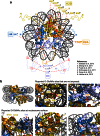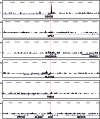A critical perspective of the diverse roles of O-GlcNAc transferase in chromatin
- PMID: 25894967
- PMCID: PMC4666902
- DOI: 10.1007/s00412-015-0513-1
A critical perspective of the diverse roles of O-GlcNAc transferase in chromatin
Abstract
O-linked β-N-Acetylglucosamine (O-GlcNAc) is a posttranslational modification that is catalyzed by O-GlcNAc transferase (Ogt) and found on a plethora of nuclear and cytosolic proteins in animals and plants. Studies in different model organisms revealed that while O-GlcNAc is required for selected processes in Caenorhabditis elegans and Drosophila, it has evolved to become required for cell viability in mice, and this has challenged investigations to identify cellular functions that critically require this modification in mammals. Nevertheless, a principal cellular process that engages O-GlcNAcylation in all of these species is the regulation of gene transcription. Here, we revisit several of the primary experimental observations that led to current models of how O-GlcNAcylation affects gene expression. In particular, we discuss the role of the stable association of Ogt with the transcription factors Hcf1 and Tet, the two main Ogt-interacting proteins in nuclei of mammalian cells. We also critically evaluate the evidence that specific residues on core histones, including serine 112 of histone 2B (H2B-S112), are O-GlcNAcylated in vivo and discuss possible physiological effects of these modifications. Finally, we review our understanding of the role of O-GlcNAcylation in Drosophila, where recent studies suggest that the developmental defects in Ogt mutants are all caused by lack of O-GlcNAcylation of a single transcriptional regulator, the Polycomb repressor protein Polyhomeotic (Ph). Collectively, this reexamination of the experimental evidence suggests that a number of recently propagated models about the role of O-GlcNAcylation in transcriptional control should be treated cautiously.
Figures



Similar articles
-
Undetectable histone O-GlcNAcylation in mammalian cells.Epigenetics. 2015;10(8):677-91. doi: 10.1080/15592294.2015.1060387. Epigenetics. 2015. PMID: 26075789 Free PMC article.
-
Histone methyltransferase Dot1L recruits O-GlcNAc transferase to target chromatin sites to regulate histone O-GlcNAcylation.J Biol Chem. 2022 Jul;298(7):102115. doi: 10.1016/j.jbc.2022.102115. Epub 2022 Jun 9. J Biol Chem. 2022. PMID: 35690146 Free PMC article.
-
OGT mediated histone H2B S112 GlcNAcylation regulates DNA damage response.J Genet Genomics. 2015 Sep 20;42(9):467-75. doi: 10.1016/j.jgg.2015.07.002. Epub 2015 Jul 23. J Genet Genomics. 2015. PMID: 26408091
-
O-GlcNAcylation and chromatin remodeling in mammals: an up-to-date overview.Biochem Soc Trans. 2017 Apr 15;45(2):323-338. doi: 10.1042/BST20160388. Biochem Soc Trans. 2017. PMID: 28408473 Review.
-
'O-GlcNAc Code' Mediated Biological Functions of Downstream Proteins.Molecules. 2018 Aug 6;23(8):1967. doi: 10.3390/molecules23081967. Molecules. 2018. PMID: 30082668 Free PMC article. Review.
Cited by
-
Conversion of Germ Cells to Somatic Cell Types in C. elegans.J Dev Biol. 2020 Oct 7;8(4):24. doi: 10.3390/jdb8040024. J Dev Biol. 2020. PMID: 33036439 Free PMC article. Review.
-
O-GlcNAc homeostasis contributes to cell fate decisions during hematopoiesis.J Biol Chem. 2019 Jan 25;294(4):1363-1379. doi: 10.1074/jbc.RA118.005993. Epub 2018 Dec 6. J Biol Chem. 2019. PMID: 30523150 Free PMC article.
-
O-GlcNAcylation modulates Bmi-1 protein stability and potential oncogenic function in prostate cancer.Oncogene. 2017 Nov 9;36(45):6293-6305. doi: 10.1038/onc.2017.223. Epub 2017 Jul 17. Oncogene. 2017. PMID: 28714959
-
Regulation of chromatin and gene expression by metabolic enzymes and metabolites.Nat Rev Mol Cell Biol. 2018 Sep;19(9):563-578. doi: 10.1038/s41580-018-0029-7. Nat Rev Mol Cell Biol. 2018. PMID: 29930302 Free PMC article. Review.
-
H2A O-GlcNAcylation at serine 40 functions genomic protection in association with acetylated H2AZ or γH2AX.Epigenetics Chromatin. 2017 Oct 30;10(1):51. doi: 10.1186/s13072-017-0157-x. Epigenetics Chromatin. 2017. PMID: 29084613 Free PMC article.
References
Publication types
MeSH terms
Substances
LinkOut - more resources
Full Text Sources
Other Literature Sources
Molecular Biology Databases
Miscellaneous

